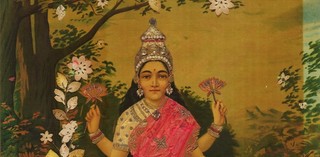QAGOMA embarks on world leading conservation project to conserve Raja Ravi Varma oleographs

Raja Ravi Varma / India 1848–1906 / Ravi Varma Press / Karla-Lonavla, India / Laxmi 1894, printed c.1910–20 / Oleograph with fabric and zardozi embroidery, before conservation treatment / Purchased 2024 with funds from the Henry and Amanda Bartlett Trust through the Queensland Art Gallery | Gallery of Modern Art Foundation / Collection: QAGOMA / View full image
The Queensland Art Gallery l Gallery of Modern Art (QAGOMA) has embarked on a world-leading conservation and research exchange with colleagues in India to document and conserve a collection of Raja Ravi Varma embellished oleographs.
QAGOMA Director Chris Saines said the singular collection of 48 uniquely embroidered Raja Ravi Varma oleographs — prints designed to resemble oil paintings — had been acquired by the Gallery through the Henry and Amanda Bartlett Trust in 2024.
‘The Gallery is grateful to have secured a significant Maitri Grant through the Australian Government and administered by the Centre for Australia-India Relations to support this world leading research and conservation project, which will include digital storytelling,’ Mr Saines said.
‘Staff travel to India will enable the exchange of specialist knowledge and research and conservation techniques with colleagues at the Museum of Art and Photography in Bengaluru, and the study of works by Raja Ravi Varma across India.
‘This cultural exchange will be an opportunity to connect with global and diaspora audiences and be instrumental in conserving these beautiful works for future generations,’ Mr Saines said.
Raja Ravi Varma (1848–1906) was a renowned Indian artist whose work gave vivid form to Hindu gods and goddesses, aristocrats and maharajahs, as well as scenes from everyday life. His works opened access to images of the deities at a time when temples were reserved for the elite.
Originally a painter popular with the royal courts, Raja Ravi Varmi established a printing press in Mumbai in 1894 with imported German machines and techniques, enabling him to develop high-quality prints based on his paintings.
By the early 1900s, images of the oleographs produced by the Raja Ravi Varma Press permeated Indian popular culture and the lives of everyday people, appearing on calendars, match-box labels, posters, postcards and advertisements, and influencing the development of Indian cinema and contemporary art.
Tarun Nagesh, Curatorial Manager of Asian and Pacific Art, QAGOMA said the collection of Raja Ravi Varma Press works acquired by the Gallery included some of the artist’s most iconic images, printed by the Press from the late 1800s and continuing after his death. They feature Hindu gods and goddesses in scenes adapted from mythological stories and epic poems such as the Mahābhārata, the Ramayana and the Puranas.
‘The works depict deities such as Lakshmi, Sarasvati, Krishna and Ram and reflect a fusion of Ravi Varma’s European art training with a purely Indian sensibility and iconography.
‘Many of these works were originally displayed in private domestic settings, in devotional puja rooms and spaces for worship. Some have been lovingly hand-embellished with brightly coloured cloth, beads and zardozi embroidery,’ Mr Nagesh said.
‘Printed and subsequently embellished a century or more ago, these works require significant and complex conservation treatment to stabilise their condition.’
Once conserved through this ground-breaking conservation exchange, a selection of the Raja Ravi Varma Press oleographs will be shown from September 2025 as a highlight of QAGOMA’s free exhibition ‘The God of Small Things: Faith and Popular Culture’, on display at the Queensland Art Gallery until October 2026.
QAGOMA’s conservation and research exchange is supported by the Centre for Australia-India Relations. QAGOMA is proud to be a recipient of a Centre for Australia-India Relations Maitri grant.
ENDS

